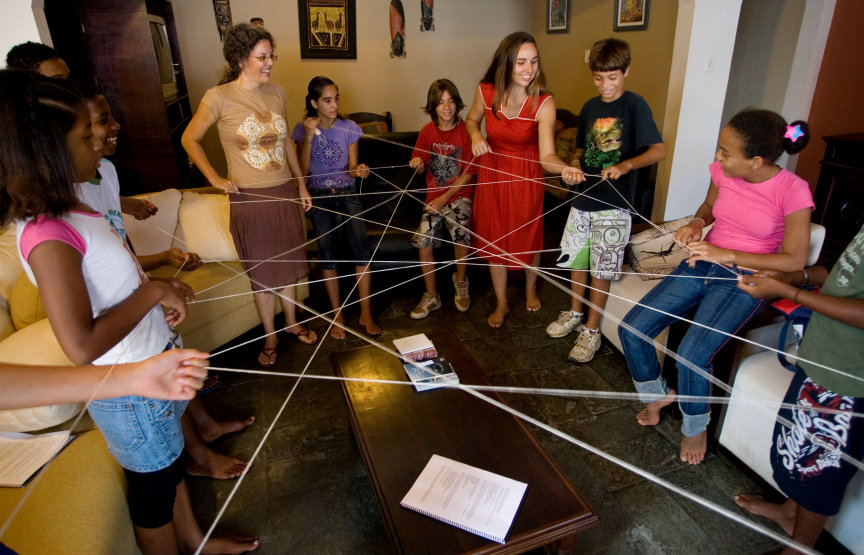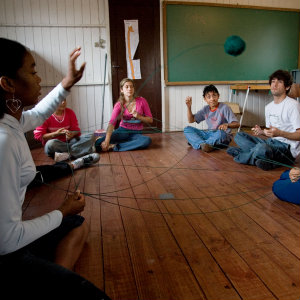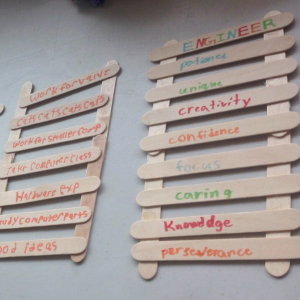Highlighting Australia
- As a proudly Australian initiative, we’re excited to showcase a collection of Australian stories, music, tributes and more.

Join activities, celebrations, study groups, spiritual empowerment and education programs for young people, and more.
Baha’i beliefs address essential spiritual themes for humanity’s collective and individual advancement. Learn more about these and more.

Featured in: Junior Youth
Across Australia young people are participating in an endeavour that strives to give them a voice in today’s society. Through the Junior Youth Spiritual Empowerment Program, these junior youth groups are enhancing their power of expression, sharpening their spiritual perception, analysing the constructive and destructive forces of society and changing their surroundings through the service projects.

One of the interesting features of the Junior Youth Spiritual Empowerment Program (JYSEP) is the fact that the arts are used to explore the various concepts presented in the series of books the particpants go through. While the use of the arts is something which happens organically and the participants themselves are encouraged to come up with artistic ways and ideas to explore these concepts, sometimes sharing ideas of activities can help to get things going.
So if you’ve got a junior youth group and are looking for some more ideas of activities to help you jump-start those creative engines, here are three ideas we’ve used with our junior youth groups which are a lot of fun and may help!
What you need: A ball of yarn or string, junior youth, and an animator!

Book 5 teaches us that, “everything we do in the spirit of helping others can be considered service.”
With this in mind it shows us that service is quite a broad concept and can be explored in many ways. To help our junior youth group advance their understanding about service, we got a ball of yarn and asked all the junior youth to stand up in a circle. When everyone was standing we asked them each to think about what their role in the community is and what would they like to be when they grow up (eg: teacher, doctor, musician, etc.).
Each person then goes around and says to the group what their role is or will be in the future. Afterwards, one person starts with yarn in hand and, again repeats their role in the community, holds on to part of the yarn and then passes the ball of yarn to another one of their friends. Upon passing the ball of yarn they must state how they are being of service to the person they are passing the yarn to (for example: As a doctor in this community, I serve the teacher by helping him/her when they are sick.) This continues until everyone has received and passed the ball of yarn and you are left with a web-like structure in the middle of the circle of friends.
They key part of this activity is to ask one junior youth to drop their portion of the yarn and then it shows that the whole web falls apart. This shows that, as human beings, we all depend on each other because we are all members of one human family – and if we do not all do not support and be of service to each other, everything falls apart.
What you need: Popsicle sticks, glue, markers/texters, junior youth, and an animator!

The idea of ‘what we want to be when we get older’ is brought up many times throughout the junior youth program. Musonda and Rose talk about it so often in Breezes of Confirmation that it gets us thinking! Similarly, in Learning About Excellence, we are asked to think about our higher goals in life.
Often, junior youth have goals in relation to their future career. An activity we do when they talk about their career goals is the Ladder activity, where we create a ladder out of popsicle sticks!
This ladder can be made in any way as long as there are steps and it is reaching a destination. On each step of the ladder the junior youth are asked to put a spiritual quality which will assist them in achieving their higher goal in life. The top step of the ladder can state what this higher goal is.
What you need: An open space (forest is ideal!), junior youth, and animators!

Our junior youth get so excited whenever they hear we are all going to play camouflage together!
To play camouflage, it’s best to go outside. Ideally you would go into a forest area, but if not, then any space where you can hide will work just as well.
Here’s how it works.
There is one person that is chosen to be “it” – that is, the person whose job it is to find out where everyone is hiding. The person who is “it” closes their eyes and counts to 30, which gives all the other players a bit of time to find a hiding place. After counting to 30, the person who is “it” opens their eyes and attempts to find where everyone is hidden by looking around, but they have to remain standing in the same place throughout the whole game. If the person who is “it” manages to find another player, that player gets called out of the game and becomes an observer! This goes on until there is only one player left in hiding.
During the game, there are a few things the person that is “it” can call out to make it easier to find where the other players are hiding.
1. “Food for 10!” – When the person that is “it” calls out “Food for 10!” they close their eyes for 10 seconds and everyone that was hiding has to move forward to slap the hand of the person that is “it” and then move back quickly to their hiding spots before the 10 seconds is up. (The amount of time can be changed if you think the other players might need more time so you can also call out “Food for 15” for 15 seconds, “Food for 20” for 20 seconds etc).
The players that are hiding have to be very quick because there is a time limit to get “food” (slap the hand of the person who is “it”). When the time is up, the person who is “it” opens their eyes to look around, and so if the other players haven’t made it back to their hiding spot in time, they can be found and called out!
2. “Scramble for 10!” – When the person who is “it” calls out “Scramble for 10!”, they close their eyes for 10 seconds and all the other players in hiding have to change their hiding spots, again remembering that they only have 10 seconds to do so, before the person who is “it” opens their eyes and begins looking around! (Again, the amount of time for this can be changed so you can choose to call out “Scramble for 15” which means the players have 15 seconds to switch hiding spots, “Scramble for 20” which means the players 20 seconds to switch hiding spots etc.)
3.“Animal Noises!” – When the person who is “it” calls out “Animal Noises!”, everyone who is hiding yells out an animal noise. This makes it easier for the person who is “it” to locate their hidden friends.
4. “Fingers!” – When the person who is “it” calls out “Fingers!”, they have to put up their hand and hold up a certain number of fingers. Then everyone who is hiding has to look at the hand of the person who is “it” and yell out the number of fingers that are being held up. The people that are hiding need to be very careful not to be seen when they move their head to look at the number of fingers that the person who is “it” is holding up!
These are the things that the person who is “it” can call out at any time during the games to make it easier to see where the other players are hidden without moving from where they are standing.
Well that’s it for now, and we hope you find these activities helpful and a lot of fun!
Images used:
– Header image: Courtesy Baha’i World Centre.
– ‘Yarn Activity’ image: Courtesy Baha’i World Centre.
– ‘Ladder Activity’ image: Courtesy Pegah Seisan & Hoda Keshavarz-Rahbar.
– ‘Camouflage’ image: Courtesy renu parkhi under Flickr creative commons.
"*" indicates required fields

We recognise their continuing connection to land, waters and community. We pay our respects to Aboriginal and Torres Strait Islander people and their cultures; and to elders both past and present.
The views expressed in our content reflect individual perspectives and do not represent authoritative views of the Baha’i Faith.

Visit the site of the
Australian Baha’i Community
and the Baha’i Faith Worldwide
Notifications
good job pegah
olesya m (March 3, 2015 at 6:05 AM)
Great work Pegz. You’re an inspiration to all <3
Rozita (March 3, 2015 at 5:23 PM)
Nice, I could try this for Gordon Head!
Lorenzo S (March 3, 2015 at 10:27 PM)
What a great way to learn how to draw a nine-pointed star! (The yarn idea)
While planning Baha’i youth activities, I recalled how, back in Sunday School, we used to make “sheep” out of cardboard toilet-paper tubes and cotton balls. Then I had a burst of inspiration! Using the same materials (but standing the tube on end), I led the class in making cute little figures of Abdul-Baha.
Betty (March 3, 2015 at 6:34 AM)
I don’t know if figures of the Master are the most appropriate thing to be making.
Shokat (March 3, 2015 at 4:32 AM)
GOOD GOOD VERY GOOD FOR BAHAI ACTIVITIES
SABA (March 3, 2015 at 8:32 AM)
I very much like the JY game activities you presented as I’m also an animator. Good sharing.tq very much hope to hear more.
arasan (January 1, 2016 at 1:35 PM)
These were really useful. Going to use the first two in a mini youth conference happening in our city…
Chad (September 9, 2016 at 3:02 PM)
We’re so glad you found this helpful, Chad! Thanks for reading!
Sonjel Vreeland (September 9, 2016 at 3:59 PM)
Can someone help me for more activities and projects which I can conduct with my JY? FOR BOC, GOH, WTSP AND DPW
Ramveer K. (April 4, 2019 at 1:16 PM)
Allah’u’abha from vanuatu..great job woww i learn alot from that creative activity..
cassandra (May 5, 2017 at 3:21 AM)
Great ideas! and amazing innovation…which is a challenge when conducting a JYG.
Tiffin (November 11, 2017 at 3:18 PM)
Thanks for sharing. Really helpful for us animators
Itinteang Korere (April 4, 2021 at 12:54 AM)